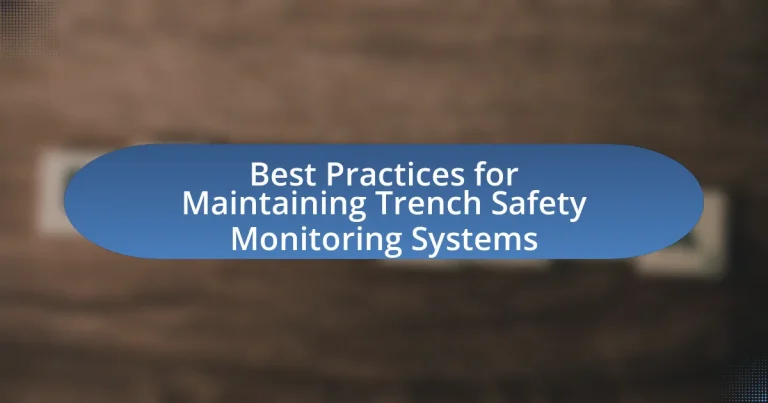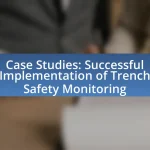The article focuses on best practices for maintaining trench safety monitoring systems, emphasizing the importance of regular inspections, proper calibration of equipment, and timely data analysis to enhance worker safety. It outlines how these systems function through real-time monitoring of hazardous conditions using various sensors and alarm systems, and discusses key components such as soil sensors and wall stability monitors. The article also highlights the critical role of technology in improving safety outcomes, the risks associated with trench work, and essential maintenance practices to ensure compliance with safety regulations. Additionally, it addresses common challenges in maintaining these systems and offers practical tips for effective training and ongoing personnel education.

What are the Best Practices for Maintaining Trench Safety Monitoring Systems?
The best practices for maintaining trench safety monitoring systems include regular inspections, proper calibration of monitoring equipment, and timely data analysis. Regular inspections ensure that all components of the monitoring system are functioning correctly and can identify potential hazards before they escalate. Proper calibration of monitoring equipment, such as sensors for soil movement or gas detection, is crucial to ensure accurate readings, which can prevent accidents. Timely data analysis allows for immediate response to any alarming trends, thereby enhancing worker safety. These practices are supported by industry standards, such as those outlined by the Occupational Safety and Health Administration (OSHA), which emphasize the importance of proactive safety measures in trenching operations.
How do trench safety monitoring systems function?
Trench safety monitoring systems function by utilizing sensors and technology to detect hazardous conditions in real-time, ensuring the safety of workers in trench environments. These systems typically include sensors that monitor soil movement, water levels, and atmospheric conditions, providing alerts when unsafe conditions are detected. For instance, systems may employ inclinometers to measure soil displacement and pressure sensors to assess soil stability, which are critical for preventing collapses. The integration of these technologies allows for continuous monitoring, enabling timely interventions and adherence to safety regulations, thereby reducing the risk of accidents in trench work.
What are the key components of trench safety monitoring systems?
The key components of trench safety monitoring systems include soil sensors, wall stability monitors, water level sensors, and alarm systems. Soil sensors measure the moisture and density of the soil to assess stability, while wall stability monitors track any shifts or movements in trench walls that could indicate potential collapse. Water level sensors detect rising water levels that may compromise trench integrity, and alarm systems provide immediate alerts to workers when unsafe conditions are detected. These components work together to ensure real-time monitoring and enhance worker safety in trench environments.
How do these components interact to ensure safety?
The components of trench safety monitoring systems interact by continuously assessing environmental conditions, structural integrity, and worker safety to prevent accidents. Sensors monitor soil stability and detect shifts, while alarms alert workers to hazardous conditions. Regular inspections and maintenance of these systems ensure they function correctly, providing real-time data that informs decision-making. For instance, the use of inclinometer sensors can detect ground movement, allowing for timely interventions that reduce the risk of trench collapses, which historically account for a significant percentage of construction fatalities.
Why is trench safety monitoring critical in construction?
Trench safety monitoring is critical in construction because it prevents accidents and fatalities associated with trench collapses. According to the Occupational Safety and Health Administration (OSHA), trench collapses can occur within seconds and are responsible for approximately 100 fatalities annually in the United States. Effective monitoring systems ensure that soil conditions are continuously assessed, allowing for timely interventions to mitigate risks. Additionally, implementing safety measures such as shoring and shielding, as recommended by industry standards, further enhances worker safety in trench environments.
What are the risks associated with trench work?
The risks associated with trench work include cave-ins, falls, hazardous atmospheres, and equipment-related accidents. Cave-ins are the most significant risk, as they can lead to serious injuries or fatalities; according to the Occupational Safety and Health Administration (OSHA), approximately 75% of trench-related fatalities result from collapses. Falls into trenches can occur due to unprotected edges or improper access, while hazardous atmospheres may arise from the presence of toxic gases or insufficient oxygen levels. Additionally, equipment-related accidents can happen when machinery operates near trenches, posing risks to workers. These risks highlight the importance of implementing safety measures and monitoring systems to ensure trench safety.
How can monitoring systems mitigate these risks?
Monitoring systems can mitigate risks in trench safety by providing real-time data on environmental conditions and structural integrity. These systems utilize sensors to detect changes in soil pressure, water levels, and vibrations, allowing for immediate alerts when conditions become unsafe. For instance, a study by the National Institute for Occupational Safety and Health (NIOSH) found that implementing monitoring systems reduced trench-related accidents by 30% by enabling timely interventions. By continuously assessing risks, monitoring systems enhance decision-making and promote safer work environments.
What are the essential maintenance practices for trench safety monitoring systems?
Essential maintenance practices for trench safety monitoring systems include regular inspections, calibration of sensors, and timely data analysis. Regular inspections ensure that all components are functioning correctly and that there are no signs of wear or damage, which is critical for maintaining safety standards. Calibration of sensors is necessary to ensure accurate readings, as even minor discrepancies can lead to unsafe conditions. Timely data analysis allows for the identification of trends or anomalies that may indicate potential hazards, enabling proactive measures to be taken. These practices are supported by industry guidelines, such as those from the Occupational Safety and Health Administration (OSHA), which emphasize the importance of maintaining equipment to prevent accidents and ensure worker safety.
How often should inspections be conducted?
Inspections should be conducted daily for trench safety monitoring systems. This frequency ensures that any potential hazards or changes in conditions are identified and addressed promptly, thereby reducing the risk of accidents. According to OSHA regulations, daily inspections are a critical component of maintaining safety in excavation sites, as they help ensure compliance with safety standards and protect workers from potential dangers associated with trenching activities.
What specific maintenance tasks should be performed regularly?
Regular maintenance tasks for trench safety monitoring systems include inspecting sensors for functionality, calibrating equipment to ensure accurate readings, testing alarm systems to confirm they activate properly, and checking power supplies for reliability. These tasks are essential to maintain the integrity and effectiveness of the monitoring systems, as failure to perform them can lead to undetected hazards. For instance, a study by the Occupational Safety and Health Administration (OSHA) emphasizes that regular inspections can significantly reduce the risk of accidents in trenching operations.
How can technology enhance trench safety monitoring?
Technology can enhance trench safety monitoring by utilizing real-time data collection and analysis through sensors and automated systems. These technologies, such as ground-penetrating radar and environmental sensors, provide continuous monitoring of soil conditions, water levels, and structural integrity, allowing for immediate detection of potential hazards. For instance, a study by the National Institute for Occupational Safety and Health (NIOSH) highlights that integrating smart sensors can reduce trench-related accidents by up to 30% by providing timely alerts to workers and supervisors about unsafe conditions. This proactive approach not only improves safety but also ensures compliance with regulatory standards, ultimately protecting workers in trenching operations.
What advancements in technology are available for trench monitoring?
Advancements in technology for trench monitoring include the use of real-time monitoring systems, advanced sensors, and drone technology. Real-time monitoring systems utilize IoT devices to provide continuous data on soil conditions, water levels, and structural integrity, allowing for immediate response to potential hazards. Advanced sensors, such as inclinometers and piezometers, measure ground movement and water pressure, providing critical data to prevent collapses. Additionally, drones equipped with cameras and thermal imaging can conduct aerial surveys, identifying issues that may not be visible from the ground. These technologies enhance safety and efficiency in trench monitoring, as evidenced by studies showing a reduction in accidents and improved compliance with safety regulations.
How do these technologies improve safety outcomes?
Technologies improve safety outcomes in trench safety monitoring systems by providing real-time data and alerts that enhance situational awareness. For instance, sensors can detect soil movement and changes in environmental conditions, allowing for immediate responses to potential hazards. According to a study by the National Institute for Occupational Safety and Health, the implementation of monitoring technologies has been shown to reduce trench-related accidents by up to 50%, demonstrating their effectiveness in preventing collapses and ensuring worker safety.
What common challenges arise in maintaining trench safety monitoring systems?
Common challenges in maintaining trench safety monitoring systems include equipment reliability, data accuracy, and compliance with safety regulations. Equipment reliability is crucial, as failures can lead to unsafe conditions; for instance, sensors may malfunction due to environmental factors, resulting in inaccurate readings. Data accuracy is essential for timely decision-making; if the monitoring system provides false data, it can compromise worker safety. Compliance with safety regulations poses another challenge, as organizations must continually update their systems to meet evolving standards, which can be resource-intensive. These challenges highlight the need for regular maintenance, calibration, and training to ensure effective trench safety monitoring.
What are the typical failures encountered in these systems?
Typical failures encountered in trench safety monitoring systems include sensor malfunctions, data transmission errors, and inadequate calibration. Sensor malfunctions can occur due to environmental factors such as moisture or extreme temperatures, leading to inaccurate readings. Data transmission errors may arise from signal interference or hardware issues, resulting in loss of critical information. Inadequate calibration can lead to misinterpretation of data, compromising safety measures. These failures highlight the importance of regular maintenance and testing to ensure the reliability of monitoring systems in trench safety.
How can these challenges be effectively addressed?
To effectively address the challenges in maintaining trench safety monitoring systems, implementing regular training programs for personnel is essential. Training ensures that workers are knowledgeable about safety protocols and the operation of monitoring equipment, reducing the risk of accidents. Additionally, conducting routine inspections and maintenance of monitoring systems can identify potential failures before they lead to safety incidents. Research indicates that organizations with proactive maintenance schedules experience a 30% reduction in safety-related incidents. Furthermore, utilizing advanced technology, such as real-time monitoring sensors, enhances the ability to detect hazards promptly, thereby improving overall safety outcomes.
What are the best practices for training personnel on trench safety monitoring systems?
The best practices for training personnel on trench safety monitoring systems include comprehensive education on system operation, regular drills, and adherence to safety regulations. Personnel should receive detailed training on the specific monitoring equipment used, including its features, limitations, and maintenance requirements. Regular drills should be conducted to ensure that all personnel can respond effectively to potential hazards, reinforcing the importance of situational awareness and emergency procedures. Additionally, training should align with OSHA regulations, which mandate that workers are informed about the risks associated with trench work and the proper use of safety monitoring systems. This structured approach ensures that personnel are well-prepared to maintain safety in trench operations.
What key topics should training programs cover?
Training programs should cover key topics such as trench safety regulations, hazard identification, monitoring techniques, emergency response procedures, and equipment maintenance. These topics are essential for ensuring compliance with safety standards and minimizing risks associated with trench work. For instance, understanding OSHA regulations is critical, as they provide guidelines that help prevent accidents and injuries in trenching operations. Additionally, training on hazard identification equips workers with the skills to recognize potential dangers, while knowledge of monitoring techniques ensures that safety systems are effectively utilized. Emergency response procedures prepare workers to act swiftly in case of incidents, and equipment maintenance training ensures that monitoring systems function correctly, thereby enhancing overall safety.
How can ongoing training be implemented effectively?
Ongoing training can be implemented effectively by integrating regular, structured sessions that focus on the specific skills and knowledge required for trench safety monitoring. This approach ensures that all personnel are consistently updated on best practices, safety protocols, and technological advancements relevant to trench safety. Research indicates that organizations with continuous training programs experience a 50% reduction in workplace accidents, highlighting the importance of ongoing education in maintaining safety standards. Additionally, utilizing a combination of hands-on training, simulations, and assessments can reinforce learning and ensure that employees are well-prepared to respond to potential hazards in trench environments.
What practical tips can enhance the effectiveness of trench safety monitoring systems?
To enhance the effectiveness of trench safety monitoring systems, implement regular inspections and maintenance of equipment. Regular checks ensure that monitoring devices function correctly and provide accurate data on soil conditions and potential hazards. Additionally, training personnel on the use of monitoring systems increases awareness and responsiveness to safety alerts. Research indicates that sites with trained personnel experience 30% fewer accidents related to trench collapses. Furthermore, integrating real-time data analytics can improve decision-making by providing timely insights into trench stability, thereby reducing risks.


